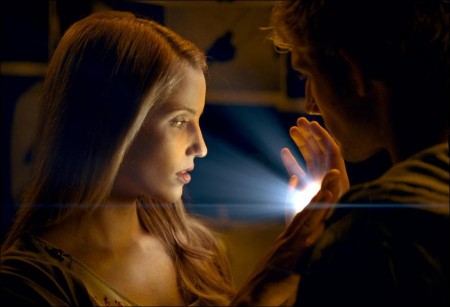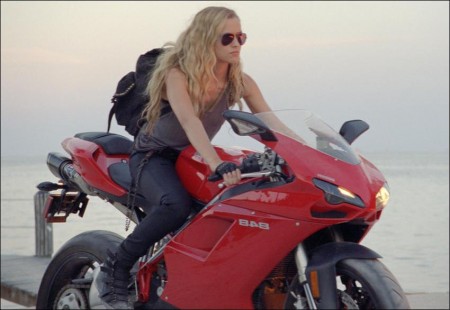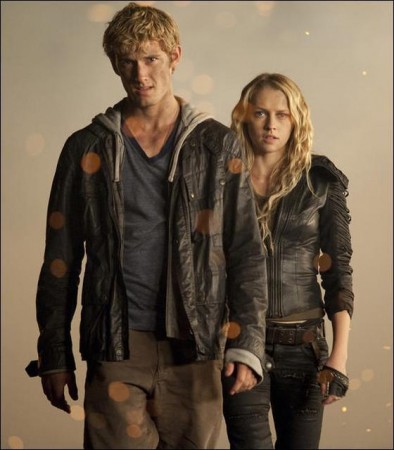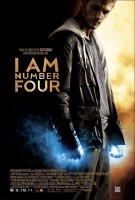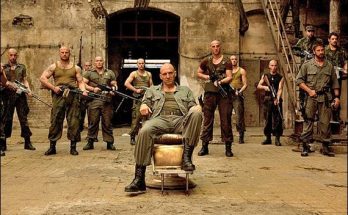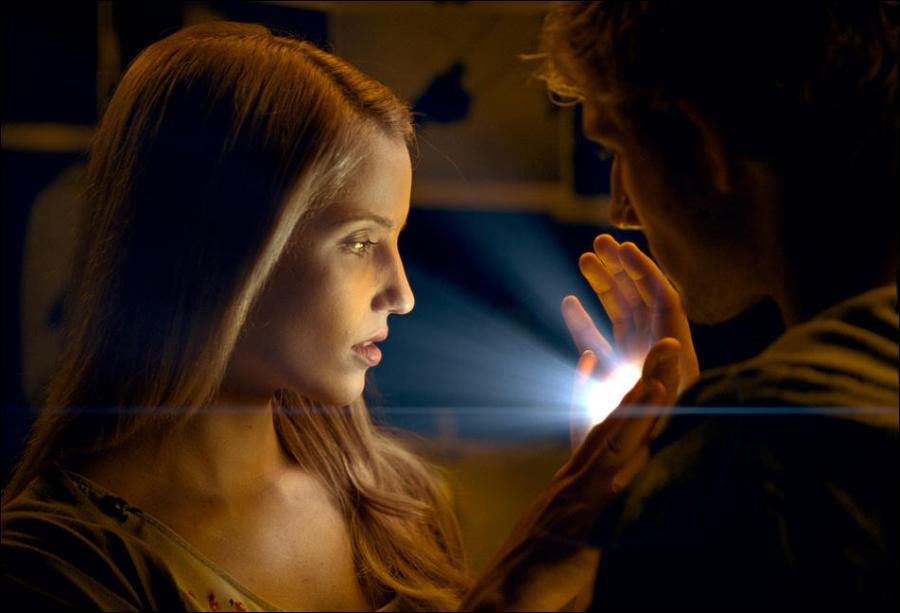Extraordinary teen John Smith is a fugitive on the run from ruthless enemies sent to destroy him. Changing his identity, moving from town to town with his guardian Henri, John is always the new kid with no ties to his past. In the small Ohio town he now calls home, John encounters unexpected, life-changing events-his first love, powerful new abilities and a connection to the others who share his incredible destiny.
I Am Number Four is an American teen action science fiction film, directed by D. J. Caruso, starring Alex Pettyfer, Timothy Olyphant, Teresa Palmer, Dianna Agron and Callan McAuliffe. The screenplay by Alfred Gough, Miles Millar and Marti Noxon is based on the novel I Am Number Four by Pittacus Lore. Produced by Michael Bay, I Am Number Four was the first film production from DreamWorks Pictures to be distributed by Touchstone Pictures, as part of the studio’s distribution deal with Walt Disney Studios Motion Pictures. The Hollywood Reporter estimated the budget to be between $50 and $60 million. The film was released in both conventional and IMAX theatres on February 18, 2011.
About the Production
Three are dead. He is Number Four. D.J. Caruso helms a suspense-thriller about an extraordinary young man, John Smith (Alex Pettyfer), who is a fugitive on the run from ruthless enemies sent to destroy him. Changing his identity, moving from town to town with his guardian Henri (Timothy Olyphant), John is always the new kid with no ties to his past. In the small Ohio town he now calls home, John encounters unexpected, life-changing events—his first love (Dianna Agron), powerful new abilities and a connection to the others who share his incredible destiny.
Director D. J. Caruso (“Eagle Eye,”“Disturbia”) has enjoyed a long-standing relationship with Steven Spielberg and DreamWorks, so he was excited to helm “I Am Number Four.” “My collaboration with DreamWorks started when I was directing a television series called ‘High Incident,’ explains Caruso. “Years later we teamed up on ‘Disturbia,’ then we worked together again on ‘Eagle Eye,’ which was another successful collaboration. I feel like I am part of the DreamWorks family, and it has become my home as a filmmaker.”
“I Am Number Four” is the biggest effects movie Caruso has ever done and he is finding Michael Bay’s experience as a director of such mega-hits as “Transformers” and “Armageddon” an invaluable help. “Michael has been very helpful with the physicality of what needs to happen on set when you are dealing with a CG character,” explains Caruso.
Producer Michael Bay equally admires his director, “D.J. has an incredible ability to get in touch with the reality of his young characters’ lives. It’s not easy to make an alien kid with super powers feel real—an authentic hero that audiences could relate to.”
Michael Bay was drawn to the story’s unusual premise. “I’ve always been attracted to stories about ordinary people forced into extraordinary situations. Number Four is almost the opposite— an extraordinary guy who wants nothing more than to have a normal life,” he says.
Caruso admits that he is interested in characters who are going through a dark period. “Through that darkness they figure out where the light is, and they find something good. What I enjoy exploring is the notion that you have to experience some bad things in order to grow up, and to find out who you are. Thematically, that happens in this movie as well.”
“When I first saw the manuscript for the book, I knew it would make a great movie. It was a new twist on a classic concept, with a great combination of realism and action.”—Michael Bay, producer
The Cast and Characters
The filmmakers were excited to put together a cast for “I Am Number Four” that would showcase the energy and intensity of the well-drawn characters. The first task was to fill the role of John Smith, aka Number Four. Caruso knew he had to find someone with a strong personality who also had a sensitive side to portray the character. “John’s extraordinary abilities make him very different from the other kids in school, which in turn makes it very hard for him to fit in,” Caruso says. “A lot of teenagers can relate to that, particularly those who have to move to a new town at that age,” he adds. “Trying to integrate into high school is tough for anyone. There is a universal aspect to his character that the audiences can hang on to because even though he is superhuman, the emotions that he has are something that a normal teenager would be experiencing.”
Many weeks went into the selection process as the filmmakers looked for that one actor who would have the attitude and physical prowess to bring John Smith to life. When Alex Pettyfer had his first read, D.J. Caruso knew that he had someone special on his hands. “I feel that Alex has a really special gift,” Caruso says. “As interesting, attractive and dynamic as he is, he has an incredible vulnerability that really works for the character. I think it will make audiences fall in love with him.”
Producer Michael Bay says of Pettyfer: “I’ve been watching Alex for a long time. He’s got a ton of charisma and physicality. As Number Four, he brought a mix of strength and vulnerability that not a lot of young actors can pull off.”
Alex Pettyfer was delighted to land the lead role of John Smith for two reasons. The first was Pettyfer’s desire to work with D.J. Caruso. “D.J. is incredible,” he explains. “I came onto this movie because I think he’s got an amazing vision. He brings something different to the table. He brings science fiction into a world and makes it real,” says Pettyfer. The second was the story and the role. “It’s a really cool premise,” explains Pettyfer. “John Smith is at a point in his life where he has a choice and his dilemma is that he wants to be a normal kid but he has been given this destiny of becoming a warrior. He is initially very reluctant and has a James Dean ‘Rebel Without a Cause’ outlook. He has the kind of temperament that you feel could explode at any moment.
“John is trying to find out who he is and what he wants to do with his life,” Pettyfer continues. “A lot of kids are going to relate to what he is going through in the story—being an outsider and trying to fit in.”
Caruso chose actress Dianna Agron to play the pivotal role of Sarah. However, he didn’t discover her by watching her Emmy® Award–winning television series, “Glee.” “I don’t watch a lot of television,” Caruso says. “She came in to read very late in the process and she knocked me out. She’s so dynamic, intelligent and beautiful. I thought she would be a great contrast to Alex with their very different personalities and the dynamic they have between them.”
“Sarah is an outsider too because even though she’s beautiful and at one time was popular, she made some decisions that made her not popular in the school anymore. So Sarah’s sitting on the outside, and John’s sitting on the outside. And together they find common ground.”—D.J. Caruso, director
Dianna Agron was immediately taken with the script. “What I loved about it was that the kids are quite mature and wise beyond their years,” Agron explains. “They might not be quote-unquote ‘cool kids’ or be the ones that pursue typical teenage activities, but they have a lot of heart and spirit, and they go on an awesome journey together.
“I also loved the character of Sarah,” Agron continues. “There are a lot of similarities to how I was in school. I love photography and I really started getting into it during high school, taking photos for the yearbook.”
In the film, Sarah is immediately attracted to John. “John is quite unusual and they have a very intense connection right from the start,” Agron explains. “It gets deeper throughout the story. Their relationship is very romantic. It’s that young love that isn’t tainted by any sort of fear—when you haven’t had your heart broken five hundred times.”
Caruso was looking for someone very special to play the role of Number Six. She needed to be able to take on the intense stunt work that was required of the character. After a long search, he found actress Teresa Palmer (“Bedtime Stories,” “Grudge 2,” “Sorcerer’s Apprentice”). “Number Six is a really powerful, dark, mysterious character,” says Caruso. “Teresa embodies the sexy confidence that was required to pull off the role. She has an infectious energy that blew me away when she read for me.”
Palmer says of her character, “Six is equally as intimidating as she is enchanting, which makes her a force to be reckoned with. She is used to surviving on her own, making her a very enigmatic and mysterious character. Six has fighting skills; her precision and timing of blows is brutal and cunning, which makes her an incredible asset in battle.”
Palmer notes that Number Six is a complex character to play. “She’s been preparing herself for battle her whole life and is incredibly skilled in martial arts and sword-fighting, but she’s quirky in an introverted way. It’s a very exciting role and really different from anything I have ever done before,” Palmer says.
“I auditioned in my natural Australian accent,” recalls Palmer. “I think they were a bit skeptical about it at first, but after we talked about it, it seemed to make sense. All nine children wouldn’t have been dropped in America; it would have been too dangerous. It was a much more interesting idea to have them land in different countries and have different accents.”
Caruso handpicked Timothy Olyphant (“Justified,” “Live Free or Die Hard”) to play Henri, John’s guardian. “Timothy is a really dynamic person and has amazing acting rhythms,” says Caruso. “It’s been wonderful to see what he has done with the role of Henri and seeing him work with Alex. It’s not like the standard father-son relationship. It’s more like an older brother or an uncle who doesn’t really know how to handle a kid.”
“My character changes throughout the movie,” Olyphant explains. “In the beginning Henri is a guardian from the planet Lorien. His role is to protect this special child as he grows on the planet Earth. As the story continues, John’s unique abilities begin to develop and grow stronger and stronger. Henri helps him understand what his destiny is.”
Reflecting on the relationship between Henri and John, Olyphant says, “I think it’s just this wonderful sort of tension, where Henri loves John, but sometimes he just wants to strangle him. If we’ve done it right, you should see that Henri’s both a bit of a hard-ass and dangerous character, but at the same time you see that he truly cares for him.”
In addition to enjoying the role of Henri, Olyphant also had a very positive experience with director D.J. Caruso. “D.J.’s just a classy guy and a great director,” he says. “Our conversations from the jump were really great and it felt like we were on the same page right from the beginning. I gave him my gut instinct about what I would like to do and he responded very positively.”
Callan McAuliffe was about to get on a plane to go home to Australia, after completing work as the male lead in Rob Reiner’s “Flipped,” when he got a call to audition for the role of Sam. “Sam has a damaged soul,” explains director D.J. Caruso. “Callan navigated his emotions perfectly. He is a natural actor who is both funny and charming.”
“Sam is a borderline nerd, but never boring. He is the kind of guy who gets bullied a lot in school,” McAuliffe says of his character. “People have always called him ‘Spaceman.’
He gets tormented all the time as a result of his interest in aliens. He got it from his father who spent all his time studying ‘close encounters’ and considered himself an ‘ancient astronautologist,’ if you will.”
McAuliffe adds, “When Sam finds out that John is an alien, he’s ecstatic! He is convinced that aliens have abducted his father and he hopes this might give him an opportunity to go and find him.”
“Kevin brought an unorthodox nature that made the Commander dangerous, yet compelling,” Caruso says. “He has the ability to change the dynamics and rhythm of a scene that raises the bar for everyone involved.”
“I met D.J. at his office,” recalls Durand. “As soon as we shook hands, I knew this was going to be a really fun experience. He’s very willing and happy to create something together. Within the structure of the script and the character, he allowed me to play and find those moments that can only come out of being spontaneous, which is really fun and exciting. It’s so cool to work with someone who is that confident in his cast.”
Durand explains his role as commander of the Mogadorian Army: “We’ve eradicated most of the Loriens, but nine children have escaped with their guardians and come to Earth. I’m tracking them down. Getting rid of them one by one, but I have to kill them in order, which makes it rather inconvenient.”
“I love the character of the Mog Commander. It’s just awesome to disappear into him and bask in the stuff he revels in; it’s so much fun. You feel like a tiger playing around with little bunnies.”—Kevin Durand
“The Commander loves this planet,” says Durand. “I think first and foremost, the thing he appreciates the most are all the toys. People on Earth have the luxury of cruising on the Internet, seeing movies, shopping and eating all these wonderful things. He loves all the great junk food.”
Creating Time and Place
Production Designer Tom Southwell has collaborated with Director D.J. Caruso on 10 previous occasions, six as his production designer. “When we first worked together,” recalls Southwell, “we came up with a system of communicating by using miniatures. We would strap a little camera to the top of a toy car and work out the car shots. On this movie, we built miniatures of the sets. D.J. would take his miniature camera to work out his camera angles. The storyboard artist would take that video and create sketches that everyone could look at and see the shots D.J. had planned.”
The story centers around a high school—the hub of the movie—so the film crew was in that setting for a long period of the film, both during the day and at night. The simplest way to get the shots was to use a real school; consequently a lot of the scenes were shot at Franklin Regional High in Murrysville, Penn. However, as Southwell points out, “There were certain sequences that we couldn’t shoot there because they involved mass destruction.”
The creative challenge for the director and his team was to take the high school “look,” which kids see every day, and make it more interesting. “One of the ways to achieve that is to use special lighting effects,” explains Southwell. “Another is by using color. I am constantly trying to influence the audience by using color because it is so psychological. You can make people feel more frightened just by taking the color out. It creates an unnatural feel that makes them uneasy. Gradually they start to feel that something terrifying is about to happen.”
Southwell adds, “The same thing is true of light; the darker it gets, the more apprehensive you get, especially if you know a creature is about to come down the hall.”
Another interesting element in the production design of “I Am Number Four” is that the sheen of everyday objects became very important. As Southwell explains, “There is very little light at some points of the movie, and the only way you are able to see our characters is in silhouette from the shine that comes off the floor. The camera department shot tests on all our materials to make sure they were getting enough sheen and difference in textures.”
Since the school hallways were the setting for the majority of the physical, special-effects work on the film, Southwell also had to rig the sets for the numerous stunts and effects that would take place there—in addition to making the corridors visually exciting and menacing.
As Visual Effects Supervisor Greg McMurry explains, “There are a lot of different types of visual effects and action sequences, and there’s a real dynamic because the characters have different abilities. We also have creatures that we worked with ILM [Industrial Light and Magic] to create; one of which is the Piken, which are unleashed by the Mogadorians.”
Special Effects Coordinator Peter Chesney worked on the design and creation of the 3500-pound iron Piken. “The Piken represents the bad guy’s bulldog, basically a 1500-pound flying squirrel with teeth,” he says.
“We had a scene where John uses his telekinesis to smash a bunch of lockers in an effort to slow up the charging Piken,” recalls Chesney. Chesney built 24 100-pound hammers that would rise up on both sides of the hallway and swing in an arc, smashing into the back of 20 lockers. Then he used a golf cart to represent the Piken and raced it down the hallway as the hammers were released one at a time in a sequence of 12 parallels.
In another scene the team used real cinder-block walls for part of the set and launched the Piken at 20 miles per hour. “The trick was that it was done with a lot of aggressive camera moves,” explains Chesney. “So we actually had to break through everything before we filmed it so that we’d get the timing right. In a lot of the camera moves, where you’re doing a whip pan with the creature running through, we would set off sparks and back time it on video during rehearsal.”
Production Designer Tom Southwell comments on the stylistic changes in the movie. “The color palette for the film is very varied,” he says. “The movie opens in an isolated hut in the African jungle. It’s brief, but it’s enough to give you a sense that there is some terror to be had in this movie. Then it moves to the Florida Keys where John and Henri are living. They live on a beautiful white beach with palm trees and aqua clear water. It’s the perfect place for a teenager.”
Henri and John live in a stilt house that is like a beachcomber’s hideaway. When John has a terrifying experience in the ocean one night, Henri realizes that they are in danger and tells John they have to leave. They grab all their belongings and leave no trace behind. “That was a big challenge,” recalls Southwell. “The house sits on this beach of sugar sand and it’s absolute paradise. We had to convince the owners to let us build a façade around the house to give us the look we wanted, and then to blow it up.”
Henri and John are forced to go on the run and they end up in Paradise, Ohio. “It’s still quite beautiful, but the colors are very pale. There is a visually boring aspect to it, maybe because it is so traditional,” says Southwell.
Director D.J. Caruso wanted Alex Pettyfer’s character John to dislike the new house in Ohio, so Southwell helped to convey that feeling by making the actual house less attractive and in direct contrast with John’s previous idyllic place. Southwell decided to break open some walls as if a renovation had been taking place, and for some unknown reason it had just stopped. He showed beams and wiring so the characters would be sitting in an unfinished room.
This was in direct contrast to the warmth Southwell created in Sarah’s home, where John would encounter the comfort of a true family environment for the first time.
Through The Lens
“Getting Guillermo Navarro as my director of photography was a gift,” says D.J. Caruso. “I’ve been a fan of his over the years, but every time I checked his availability, he was already booked. Finally when ‘The Hobbit’ was pushed, his window opened up, and I jumped on it like a flash. It has been an incredible experience working with him.” “Guillermo Navarro’s lighting comes from a very emotional place, which I much prefer to the technical side, Together we have formed this great synergy and the frames of the movie are just stunning.”—D.J. Caruso, director
“I’m always on the lookout for movies that will allow me to create realities and not necessarily just document an existing reality,” explains Navarro. “Even though, in this case, they are completely tied to our existing realities, and contemporary to our world, there is the other story about characters visiting our world that opens up how we see ourselves in our surroundings—that was what triggered my interest in this film.”
Navarro explains how his approach evolved: “I think that I have accumulated cultural baggage through my process that has allowed me to see things in a particular way. That comes from growing up in the third world where the visuals and the colors and the smells are very much a part of you. That’s how I grew up and how I fell into using images as a way to express myself. My strongest influence was a cinematographer called Ricardo Aronovich, who was a mentor for me when I was young. It’s not that I copied his style, but I learned from him how to prep a movie, how to make your point of view for what you can bring to the table and how to not have a bag of tricks or solutions. Many people expect movies to look a certain way: Space movies should look like this or Westerns should look like this. I don’t believe it should be that way.”
Actor Timothy Olyphant is a big fan of Guillermo Navarro’s work. “‘I Am Number Four’ is going to look unbelievable,” says Olyphant. “Guillermo’s lighting is just outstanding.
“I really love the way he works as well,” Olyphant adds. “He’s named all his cameras after women in famous Spanish literature. His crew has worked on all of his films and he comes with a whole family of people. It’s a wonderful environment to be around. He brought a great atmosphere to the whole set. I felt like I was collaborating as much with Guillermo as I was with D.J.; he is so passionate and engaging. With both those guys it felt like a real dialogue was happening.”
Getting in the Action
Aside from the drama of the relationships, the making of “I Am Number Four” required many different types of action sequences based on the needs of the characters in the story.
Actress Teresa Palmer had the majority of the stunt work to do in the movie. She began training about two months before shooting commenced in Pittsburgh. Explains Palmer: “I didn’t want to do Six the disservice of not knowing how to fight, so I worked with Peng Zhang, a talented fight coordinator who specializes in martial arts. We worked extensively for a few months, concentrating on kicking form—side kicks, back kicks, front kicks—and then putting that together with sword work to create the fierce action. I also worked hand-in-hand with the stunt team lead by action coordinator Brad Allan, who trained me to be able to work like one of them. Our goal was to turn me into this character, not to fake it.”
Alex Pettyfer also had several stunt scenes he needed to master. His favorite was being thrown backwards into the school lockers at 40 miles an hour. “The action is so much a part of the scene, and you’re so involved in it as it’s going on all around you. That pressure really upped the adrenaline, although jumping off a cliff backwards was one of the scariest things I have ever done,” says Pettyfer.
“I’m twenty years of age and I’m just a big kid. Not many guys get to experience what I’ve experienced. To go on a movie set and run around, and play with guns and jump off cliffs— that was really fun.”—Alex Pettyfer
Meet The Mogadorians
It was a long process to develop the look of the Mogadorians. The filmmakers researched many different options and looks for them, hoping to walk the line between normalcy and eccentricity. In the book, the Mogs, just like the Loriens, look exactly like humans, except for their extraordinary height.
“The Mogadorians are an interesting race because they’re much larger than the Lorien race or the human race would be,” director D.J. Caruso explains. “They are all about seven feet tall, if not more. They have gigantic weapons and blasters, and they are used to getting whatever they want.
“The Mogadorians come in, they take over a planet and they don’t ask any questions. They are like evil Western gunslingers that would come through towns, kill the men, destroy everything and take the women and the children. That’s basically the Mogadorian way of life.”—D.J. Caruso, director
Caruso felt it would be more interesting if the Mogs were threatening, intimidating creatures—in addition to their height. He wanted them to appear humanoid, but cause a double take when people saw them. But it was important to the believability of the story that the Mogs could blend into American society. So for Costume Designer Marie- Sylvie Deveau, the most challenging costuming aspects of the film centered on the clothes for the Mogadorians. “We needed to find the right image as well as provide for the requirements of the action,” she says.
Deveau watched a movie from the ’70s called “The Great Northfield Minnesota Raid.” “We loved the long duster coats they were wearing,” says Deveau. “We wanted something dark because most of the shots with them were at night, so it gave a subtle, menacing look.”
The costumes were extremely hot to wear, however, especially in the heat of Pittsburgh and the Florida Keys in summer. Deveau had to use an air-cooling system under the costumes and the actors had to rest in air-conditioned tents between takes. It was also a problem for the makeup: if the actors were not kept cool enough, it could literally slide off their faces.
Making the Mogadorians taller than the average human being was another challenge. In order to help give the Mogs their ominous presence, the actors wore custom Kangool boots that made them seven inches taller and gave them their odd, slow gait. The Kangools were covered with a leather faux boot to give them the appearance of normal boots.
“We spent a while trying to make them look tall without having to use stilts,” explains Deveau. “Finally the stunt coordinator found these spring boots, so we built a shoe onto them. It gave the actors about seven to eight inches extra. Given that Kevin Durand, who plays the Mog Commander, is already 6’4,” those added inches made him very imposing.”
Kevin Durand adds, “There is a hard plastic cylinder underneath. In addition to making the commander a lot taller, they also add this peculiar movement that makes him even more unique.”
During the process of defining the Mog look, Deveau brought in some research that was centered on wardrobe. Included was a photo she came across in a European magazine where the model had a tattoo in the shape of hair on his head. The idea took root that on a Mogadorian, the “hair” was actually a tattoo. The team also came up with the premise that as the soldiers rose up through the ranks of the military system in Mogadore, their tattoo became more elaborate. All the Mogs have the same basic tattoo as the base of their design and then, depending on their rank and skill level, their tattoos become more distinct.
With all the specialized makeup, it took about two hours a day to turn an actor into a Mog. The individualized tattoos and the prosthetic makeup for the Mog Commander and his henchmen were based on designs created at KNB Effects in L.A, run by Howard Berger and business partner Greg Nicotero.
“When we were hired to design the look of the Mogadorians, we needed to create an alien race that was fresh and interesting, but still could assimilate into the general population on Earth. It was a difficult challenge we were ready to face and in the end came up with character makeups that allowed the actors to perform beneath their prosthetics and tattoos and bring the Mogs to life on screen.” — Howard Berger, SPFX Makeup
In addition to acting the role, Kevin Durand also had to learn a new language—Mogadorian. “When I first looked at it, I was a little intimidated by it,” Durand recalls. “I was like, ‘Wow! This doesn’t really sound like anything I’ve ever attempted to do before.’ I love doing accents and I speak a couple of different languages, but this language was really out there, which only makes sense.”
The Mogadorian language was created specifically for the movie and was influenced by ancient Latin, Slavic languages and English. It has its own set of rules so that the director could create and change sentences on set while filming the movie. Videotapes cataloguing the phonetics of Moganese were sent to the actors in order for them to learn and practice the unique language.
“I have to say, I got really obsessive with learning it word-by-word and then perfecting the pronunciation,” says Durand. “It took me quite a while, but now I can say I am a fairly eloquent Mogadorian speaker.”
“Legacies” Come To Light
Although Lorien is located in one of the furthest galaxies, it is very similar to Earth in that Loriens breathe air and look exactly the way humans on Earth look… but that’s where the similarities end. Each of the nine children who managed to survive the destruction of Lorien and escape to Earth possess different unique abilities called “legacies.”
“An interesting thing about the legacies is that ‘the nine’ aren’t really sure what abilities they are going to inherit,” says Caruso. “As they mature and reach their teenage years, they start to discover things like lumen in their hands. It’s kind of painful, and they don’t really know what they’re supposed to do with that yet.”
“When I moved to Paradise, Ohio, and become John Smith, I begin to experience intense emotions that are triggered by Sarah,” says Alex Pettyfer. “I have these emotional highs and lows, which have built up from a mixture of jealousy and the fact that I am falling in love with her, and these intense emotions set off my abilities. The first time it happens is when I am in class one day. Mark, who used to be Sarah’s boyfriend, starts to really bug me and get on my case. I start to have this weird feeling. My hands begin burning and I am sweating profusely. As I run out of the room, I open up my hands and they burst out this light.”
Recalls Pettyfer, “I remember before I began working on the film, I was at dinner and I was putting my hand over a candle to see what it would feel like. Of course, I burned myself but that gave me a way to understand it. I realized that the lumen is not only a source of light but also a source of fire. I wanted to bring across in the film that the legacies are really painful while I am learning how to use them.”
The goal of the filmmakers was to make these abilities organic; for example, making the light appear to be coming out of Alex Pettyfer’s hands in a natural way. Director of Photography Guillermo Navarro explains his approach: “The character’s hands light up and become light sources, so we played with how that affects him and how it affects the environment. It was very tricky to find a way to patch a light to his hand without burning him, but once we figured it out it was very cool.”
“I also have telekinesis, which I discover in a humorous way,” Pettyfer says. “I have a big argument with Henri and pin him up against the house before I realize what has happened.”
“Number Six has the ability to make herself invisible,” explains Teresa Palmer. “She can disappear and then reappear in another part of the room. It’s basically teleporting. It’s an incredible skill to have in a fight because she will be in the middle of battle, then suddenly she will disappear as they are about to strike and then reappear behind them, giving her final blow to their back. It’s a very useful power and looks great on screen.”
“We had to figure out the technique of getting Six to appear and disappear,” Palmer continues. “It was a great learning curve for me. There are some CGI elements and some physical SFX involved. It’s always challenging working against a green screen, but it was very cool.”
I Am Number Four
Directed by: D.J. Caruso
Starring: Alex Pettyfer, Timothy Olyphant, Teresa Palmer, Dianna Agron, Callan McAuliffe, Kevin Durand, Jake Abel, Reuben Langdon, Emily Wickersham
Screenplay by: Alfred Gough
Production Design by: Tom Southwell
Cinematography by: Guillermo Navarro
Film Editing by: Vince Filippone, Jim Page
Costume Design by: Marie-Sylvie Deveau
Set Decoration by: Maria Nay
Art Direction by: Douglas Cumming, John B. Josselyn, Paul D. Kelly, Gary Kosko
Music by: Trevor Rabin
MPAA Rating: PG-13 for intense sequences of violence and action, and for brief language.
Studio: DreamWorks Pictures
Release Date: February 18, 2011 events
Hits: 174
